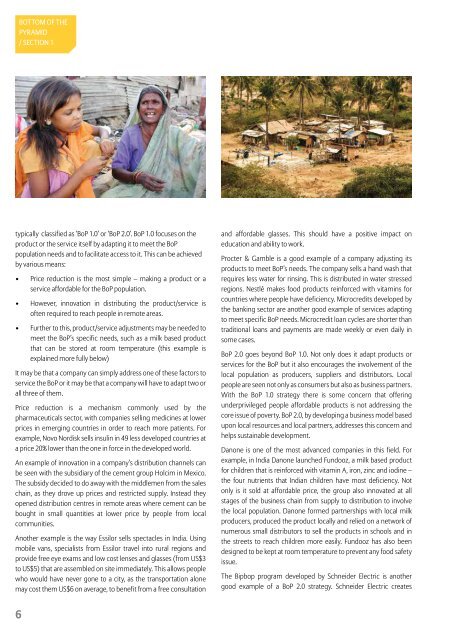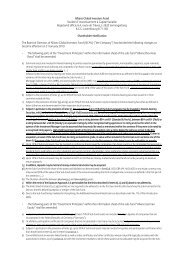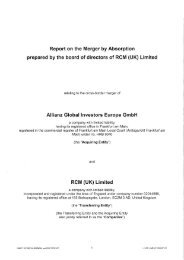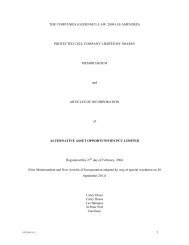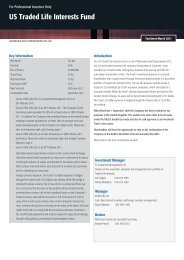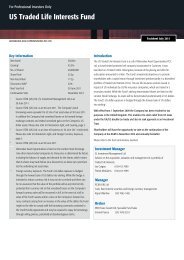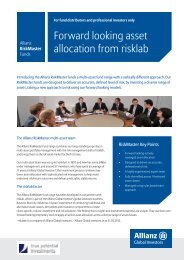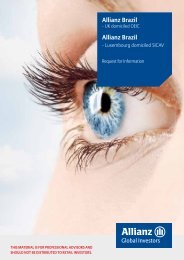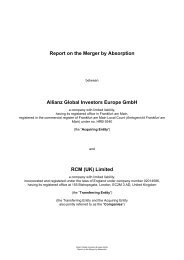ottom of thepyramid/ section 1typically classified as ‘BoP 1.0’ or ‘BoP 2.0’. BoP 1.0 focuses on theproduct or the service itself by adapting it to meet the BoPpopulation needs and to facilitate access to it. This can be achievedby various means:• Price reduction is the most simple – making a product or aservice affordable for the BoP population.• However, innovation in distributing the product/service isoften required to reach people in remote areas.• Further to this, product/service adjustments may be needed tomeet the BoP’s specific needs, such as a milk based productthat can be stored at room temperature (this example isexplained more fully below)It may be that a company can simply address one of these factors toservice the BoP or it may be that a company will have to adapt two orall three of them.Price reduction is a mechanism commonly used by thepharmaceuticals sector, with companies selling medicines at lowerprices in emerging countries in order to reach more patients. Forexample, Novo Nordisk sells insulin in 49 less developed countries ata price 20% lower than the one in force in the developed world.An example of innovation in a company’s distribution channels canbe seen with the subsidiary of the cement group Holcim in Mexico.The subsidy decided to do away with the middlemen from the saleschain, as they drove up prices and restricted supply. Instead theyopened distribution centres in remote areas where cement can bebought in small quantities at lower price by people from localcommunities.Another example is the way Essilor sells spectacles in India. Usingmobile vans, specialists from Essilor travel into rural regions andprovide free eye exams and low cost lenses and glasses (from US$3to US$5) that are assembled on site immediately. This allows peoplewho would have never gone to a city, as the transportation alonemay cost them US$6 on average, to benefit from a free consultationand affordable glasses. This should have a positive impact oneducation and ability to work.Procter & Gamble is a good example of a company adjusting itsproducts to meet BoP’s needs. The company sells a hand wash thatrequires less water for rinsing. This is distributed in water stressedregions. Nestlé makes food products reinforced with vitamins forcountries where people have deficiency. Microcredits developed bythe banking sector are another good example of services adaptingto meet specific BoP needs. Microcredit loan cycles are shorter thantraditional loans and payments are made weekly or even daily insome cases.BoP 2.0 goes beyond BoP 1.0. Not only does it adapt products orservices for the BoP but it also encourages the involvement of thelocal population as producers, suppliers and distributors. Localpeople are seen not only as consumers but also as business partners.With the BoP 1.0 strategy there is some concern that offeringunderprivileged people affordable products is not addressing thecore issue of poverty. BoP 2.0, by developing a business model basedupon local resources and local partners, addresses this concern andhelps sustainable development.Danone is one of the most advanced companies in this field. Forexample, in India Danone launched Fundooz, a milk based productfor children that is reinforced with vitamin A, iron, zinc and iodine –the four nutrients that Indian children have most deficiency. Notonly is it sold at affordable price, the group also innovated at allstages of the business chain from supply to distribution to involvethe local population. Danone formed partnerships with local milkproducers, produced the product locally and relied on a network ofnumerous small distributors to sell the products in schools and inthe streets to reach children more easily. Fundooz has also beendesigned to be kept at room temperature to prevent any food safetyissue.The Bipbop program developed by Schneider Electric is anothergood example of a BoP 2.0 strategy. Schneider Electric creates6
<strong>ESG</strong> <strong>Matters</strong> | <strong>Issue</strong> 5The prospective rewardsinclude growth, profits andincalculable contribution tohuman kind.solutions for reliable, affordable access to clean energy in rural areasin developing countries such as the In-Diya LED lighting system. Thissystem is deployed in India and Africa and generates light from solarpanels or batteries. In parallel, the group commits to train localentrepreneurs to ensure the maintenance of the lighting systems,change the batteries, collect payments and use those paymentsadvisedly. Schneider Electric, therefore, provides local communitieswith both electricity and jobs while generating revenue forthemselves.It must also be noted that companies have a duty to respect the BoPand must not look to exploit the BoP just for a quick profit. The veryfact that the target audience is so poor and generally lacks educationand that the market lacks suitable regulatory frameworks meansthat they are often very vulnerable. Companies must be responsiblewhen they follow BoP strategies, looking to work with the localcommunities to do what is best for all, not just for their sales.Irresponsible marketing and coercion by overzealous sales force touse unsuitable products have marred some companies BoPstrategies and reputations in the past.It is not all easy going, therefore. BoP business models are highlychallenging and companies implementing BoP strategies face anumber of issues regarding innovation needs, market knowledgeand profitability. These barriers to entry prevent some companiesfrom even trying to branch out into BoP strategies.As explained, successful BoP strategies require a high level ofadaptation and innovation, be it on the products and servicesthemselves or on the way they are produced, marketed anddistributed. The main issue for companies is to offer a qualityproduct or a service at low costs while dealing with a range ofproduction and/or distribution constraints.BoP strategies are really a laboratory of innovation for companies.They require investment in time, money and dedicated skills.Companies need to have a thorough knowledge of the market theywant to enter in. Dealing with an informal economy, red tape,corruption, and finding reliable local partners can be very difficult.Thorough knowledge of the market is also essential in order to offera product or a service that really fits local needs. The lack ofknowledge of specific local conditions is a source of frustration forsome BoP projects. That is the case for a strategy deployed by VeoliaEnvironnement in partnership with Grameen.Veolia and Grameen built a water treatment plant to supply water totwo Bangladeshi villages at a relatively low cost, whose only otheroption was to use spring water that was free but contaminated byarsenic. At the beginning, the local population would not drink thewater coming from the treatment plant and would continue to drinkthe arsenic contaminated one. Veolia Environnement asked a teamof anthropologists to conduct a local survey to understand whypeople would not buy Grameen Veolia water. The results of theinvestigation showed that villagers lacked knowledge of the exactconsequences of arsenic on health – cancer and internal lesions inlater life. Villagers did not understand the choice between theimmediate cost of the water supplied by Grameen Veolia and thepossible longer term risks.At the same time, the researchers found that there was a socialstigma associated with arsenicosis. People would not buy theGrameen Veolia water because they feared that others would thinkthey were affected by the disease. After hearing this, an educationalprogram was set up in partnerships with religious leaders, teachersand local authorities to explain to villagers the benefit of GrameenVeolia water. This finally meant the project succeeded.The greatest challenge for the BoP strategies is to achieveprofitability and to be considered as credible business projects.What with the high costs and low prices, margins are low andrequire large volumes to provide any return on investment.Strategies usually take a longer time to break even compared tostandard projects. That is why many give up on BoP strategies ornever expand them elsewhere. Furthermore, BoP strategies areoften managed by the philanthropic department of companies.They tend to be disconnected from the core business and as such,they do not benefit from usual business reporting lines, resources ordecision-making frameworks. Sometimes feasibility studies are notconducted and profitability is an after-thought. In the end, BoPstrategies migrate into corporate social responsibility projects/charity when they “should look like core business projects. It hasto be about generating revenues and selling products to thepoor – not broad based poverty alleviation” as BoP expert ErikSimanis said.Thus, it appears that one of the greatest obstacles to BoP strategiesare companies themselves. Often many companies lack thecapabilities and organisational support to make the strategies work.At the end of the day, even if BoP strategies are seen solely asphilanthropy, at least they contribute to alleviate poverty and that isalready quite an achievement. 7


